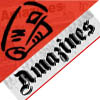|
|
 |
 |
|
Fire Retardant Fabrics by sgbvdf asga
 |

|
|

Fire Retardant Fabrics |
|
|
|
|
|
Business,Business News,Business Opportunities
|
 |
Terminology and test limitations
The term fire retardant as applied to organic (i.e., containing carbon) materials, is intended to refer to reduced fire hazard, as all will burn under certain circumstances. The tests used specified in building codes, such as NFPA 701, are more correctly flame resistance tests, which test a fabric's ability to resist ignition with the flame size and duration in the test conditions. The result is a comparative test, which provides a measure of the material's resistance to propagating combustion caused by small scale ignition sources. These tests do not predict the burning characteristics of full scale hazards. In many cases, if exposed to a sufficiently large and sustained exposure fire, the fire retardant fabrics will burn vigorously.
Fire retardant fabrics and stage drapery
Fabric flammability is an important textile issue, especially for stage drapery that will be used in a public space such as a school, theatre or special event venue. In the United States, Federal regulations require that drapery fabrics used in such spaces be certified as flame or fire retardant. For draperies and other fabrics used in public places, this is known as the NFPA 701 Test, which follows standards developed by the National Fire Protection Association (NFPA). Although all fabrics will burn, some are naturally more resistant to fire than others. Those that are more flammable can have their fire resistance drastically improved by treatment with fire retardant chemicals.
Fabric choices and fire retardance
Stage curtain fabric choices are numerous, depending on the required style of curtain.
Fire retardancy fabric treatment
The flammability of fabric can be drastically reduced through the use of fire retardants. Many natural fibers, including cotton, can be topically treated with a chemical that reduces the fabric flammability to the extent that it becomes nearly non-combustible. During a fire, the chemical reacts with the gases and tars generated naturally by the fabric, converting the gases and tars to carbon char, thus drastically slowing the fabric burning rate.
Some polyester fabrics are considered permanently fire retardant. This is because fire retardant properties are built directly into the molecular structure of the fibers. Fabrics manufactured utilizing Trevira and Avora polyester fibers are considered inherently or permanently fire retardant[citation needed]. Other synthetic fabrics may be considered durably fire retardant, fire retardant, or non-fire retardant. Durably fire retardant refers to a process in which polyesters are chemically treated during the manufacturing process with a non-water soluble chemical. In other cases, synthetic fabrics may be topically treated with chemicals after the manufacturing process (in the same manner as natural fibers such as cotton), or may be untreated (or untreatable) and therefore considered non-fire retardant.
Aramid, like Twaron is used in modern fabrics to withstand high temperatures in industry and fire-fighting.
Durability and cleaning of fabric and drapes
When a fabric is designated as inherently fire retardant, permanently fire retardant, or durably fire retardant, the flame retardancy will last for the life of the fabric. The drapery can be laundered or dry-cleaned as recommended by the drapery manufacturer. In the case of fabrics that are designated as fire retardant, that have been topically treated with chemicals, the flame retardancy of the fabric will dissipate over time, particularly with repeated cleaning. These fabrics must be dry-cleaned with a non-liquid cleaning agent.
Typically, the flame retardancy of topically treated fabric is certified for one year, though the actual length of time in which the treatment remains effective will vary based on the number of times the drapery is dry-cleaned and the environmental conditions in the location in which the drapery is used. It is recommended that topically treated drapery be re-tested for fire retardancy on an annual basis and re-treated by a qualified professional as needed.
See also
Flame retardant
References
^ NFPA 701,D1.1
External links
National Fire Protection Association
California State - Office of the State Fire Marshal
Navigating Flame Retardancy Regulations in the US
Fire Retardancy Definitions including the NFPA 701 Test
Categories: Fabrics Fire prevention Fire protectionHidden categories: Articles with limited geographic scope All articles with unsourced statements Articles with unsourced statements from December 2007 I am China Toys Suppliers writer, reports some information about customized memo pads , memo pad holders.
Related Articles -
customized memo pads, memo pad holders,
|
Rate This Article  |
|
|
 |
|
|
Do you Agree or Disagree? Have a Comment? POST IT!
| Reader Opinions |
|
|
 |
|
|
|
 |
 |
 |
| Author Login |
|
|
 |
Advertiser Login
ADVERTISE HERE NOW!
Limited Time $60 Offer!
90 Days-1.5 Million Views



 |
 |
TIM FAY

After 60-plus years of living, I am just trying to pass down some of the information that I have lea...more
|
 |
 |
 |
 |
ADRIAN JOELE

I have been involved in nutrition and weight management for over 12 years and I like to share my kn...more
|
 |
 |
 |
 |
GENE MYERS

Author of four books and two screenplays; frequent magazine contributor. I have four other books "in...more
|
 |
 |
 |
 |
LAURA JEEVES

At LeadGenerators, we specialise in content-led Online Marketing Strategies for our clients in the t...more
|
 |
 |
 |
 |
MICHAEL BRESCIANI

Rev Bresciani is the author of two Christian books. One book is an important and concisely written b...more
|
 |
 |
 |
 |
STEPHEN BYE

Steve Bye is currently a fiction writer, who published his first novel, ‘Looking Forward Through the...more
|
 |
 |
 |
 |
LEVAL AINAH

I am an internet marketer and also an educator. My goal is to help others who are looking to improve...more
|
 |
 |
 |
 |
PAUL PHILIPS

For more articles, blog messages & videos and a free e-book download go to www.NewParadigm.ws your p...more
|
 |
 |
 |
 |
ALEX BELSEY

I am the editor of QUAY Magazine, a B2B publication based in the South West of the UK. I am also the...more
|
 |
 |
|



















